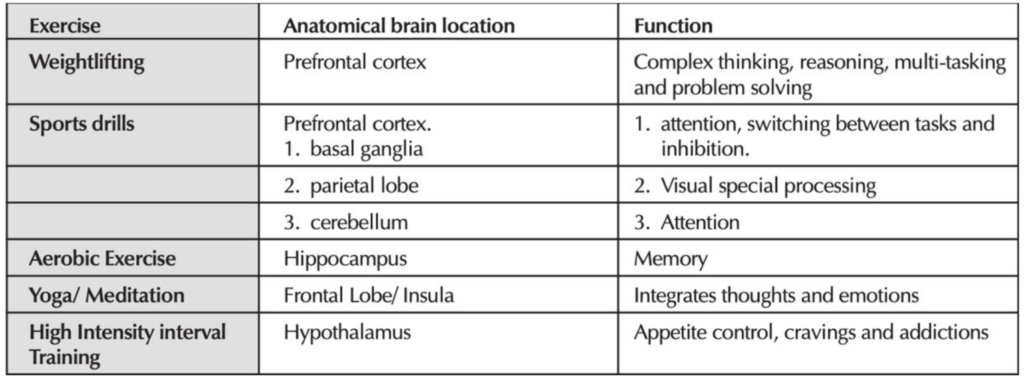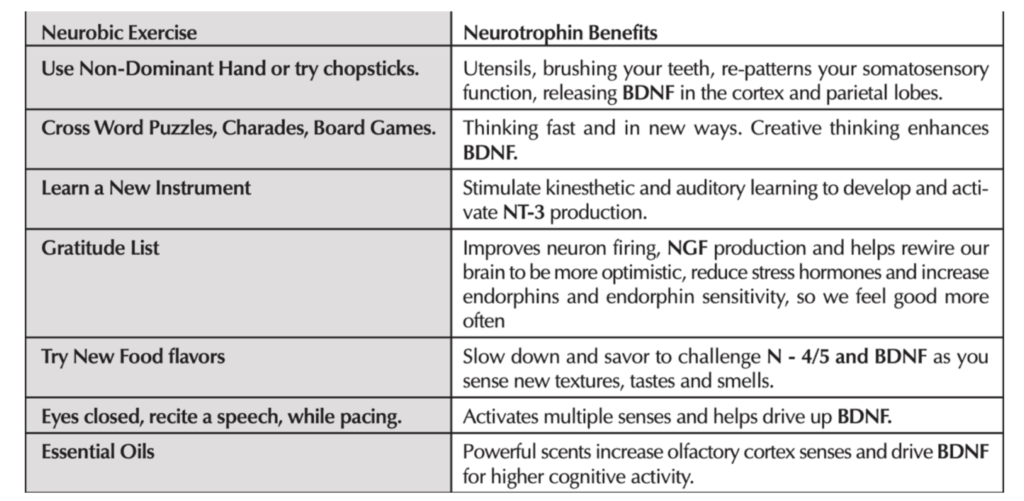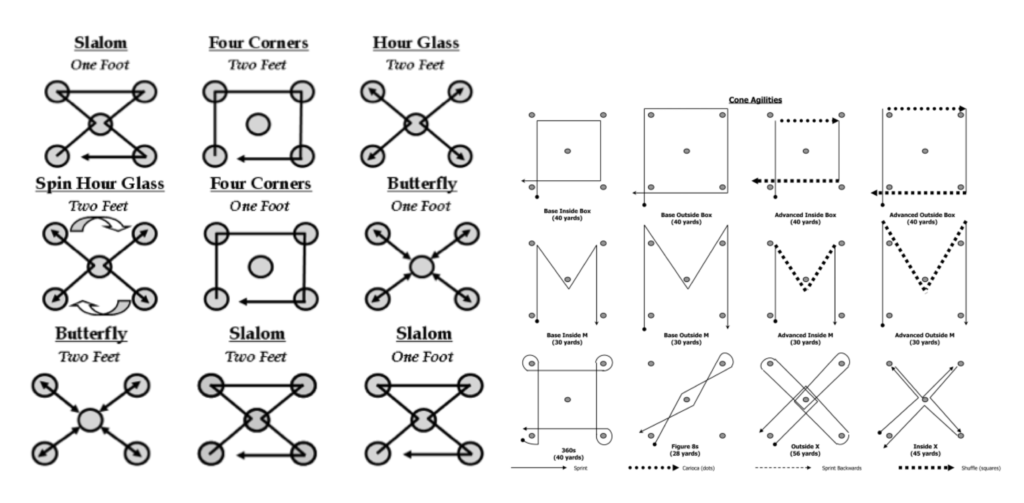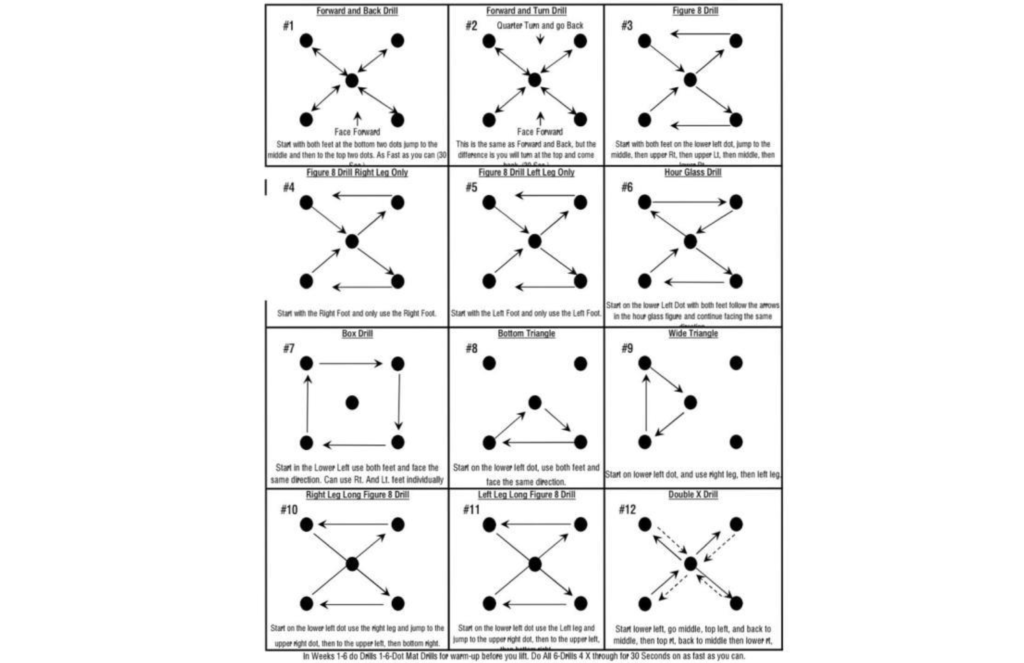Author – Lori Sherlock, Ed.D. lsherlock@hsc.wvu.edu
What are Neurobics?
- Mental exercises that challenge the brain in novel ways.
- Mental or physical activities that involve greater mental engagement or further engage the senses
Why are we Interested in Brain Health?
Cognitive decline & development of dementia or Alzheimer’s Disease
- 1 in 9 adults
- Increased risk with age
- CVD increases prevalence to 1 in 4
- Deemed public health concern by the CDC
Benefits of Neurobics
- Increased Neural activity → increased blood flow to brain → Brain cell growth
- Increased stimulation of patterned neural activity → improved cognitive function
- Improved dual task completion
- Enhanced memory, reasoning ability, cognitive function
- Reduced risk for depression
- Reduced risk of cognitive decline and Alzheimer’s Disease
- Improved mental flexibility
- Increase in BDNF production
- Improved ability to perform ADL’s
Physical Exercise is Equally Important in Brain Health

Creating Neurobics:
- Experience unexpected, novel things
- Use your senses
- Level of importance or engagement are factors
- Evoking emotion can increase the impact
- Increasing oxygen availability can improve outcome

Intensity & Complexity:
- Increased movement complexity = reduced movement intensity
- Movement complexity is subjective
- Exercise experience, movement library, etc.
- Practicing a task reduces its perceived complexity Neurobics as purposeful recovery:
- Important to perform, bur not physically strenuous = perfect for recovery
- Ways to incorporate into recovery:
- Rest Interval during a HIIT (Immediate Recovery)
- Rest between intervals or sets (Short term recovery)
- Recovery or Transition sessions (Training Recovery)
“It could be argued that the recovery period is equally important as the exercise stimulus” -SA Romero et.al
Importance of Recovery
- Exercise Stress → Muscle & Tissue Damage → Need for Repair → Recovery → Adaptation
- Without recovery, we can experience lack of progress with training, injury, overtraining syndrome, or burn-out
Active vs Passive Recovery
Active
- Light to moderate activity
- Can include short bouts of anaerobic activity
- Increases blood flow
- Accelerates metabolic waste removal
- Stimulates healing and adaptation
Passive
- Massage
- Compression
- Hydrotherapy
- Sleep – PARAMOUNT during training and recovery
- Intended to increase blood flow
Neurobics as Purposeful Recovery
Rest Interval during HIIT (Immediate Recovery)
- Work: Ski x :30 @ 9/10
- Rest: Write word on persons back with non-dominant hand and have them guess the word while marching x :60 @ 4/10
Rest Interval between intervals or sets (Short Term Recovery)
- Interval Set: Tabata
- Rest: Follow the Metronome (Faster → Slower)
Recovery or Transition Sessions (Training Recovery)
- REHIIT Protocol with Navigation 3 min easy
:30 sec Very Hard 3 min easy
:30 sec Very Hard 3 min easy
Neurobics for Purposeful Recovery Workout
Warm Up x 5 min
- Include 6-7 formula
- Incorporate Build-up Drill to 9/10
5 Min AE @ 5-7/10 + Word Play
1 min @ 6
- Grounded L Jack + Ski + Toe Touch
- Repeat Words of Song Out Loud
1 min @ 5
- Grounded R Jack + Ski + Toe Touch
- Repeat Tongue Twister
2 min @ 7
- Jog with directional changes and foot position changes
- Learn sign language
1 min @ 5
- Heel Taps Front and Back
- Draw letters on hand forward and back/dominant and nondominant
10 Min REHIIT Protocol – Navigation
3 minutes easy – Eyes Closed, March from your Front door to your Primary Bathroom 30 seconds VERY HARD
3 minutes easy – Eyes Closed, March from your Back Door to a landmark in your Yard 30 seconds VERY HARD
3 minutes easy – Eyes Closed, March from the Hotel’s front entrance to the Pool.
5 Min AE: Dot Drills with Direction, Dot & Foot Changes
HARD (9/10): Low-Moderate (6/10): Moderate (7/10): Easy (5/10): Low-Moderate (6/10): Easy (5/10):
30 seconds – X-Mogul Jumps
1 min – 5-Dot: Slalom
1:30 min – 5-Dot: Hour Glass
1 min – 5-Dot: Figure 8 Drill
1 min – 5-Dot: Wide Triangle
1 min – 5-Dot: M Drill


5 Min AE @ 5-7/10 – Add On Memory Game
Continue to add on to the combo and the group has to remember.
- Ski x 4
- Jack Cross x 2
- Tuck & Shoot F/B x 3 + bounce center
- Clap F/B single, single, double x 2
- Tap Heels behind – Opposite x 2, same x 2
- Tap Knees in front – Opposite x 2, same x 2
- Staggered Run in a circle (right begins forward, left ends forward & reverse) x 8 Seated Level 3 scull x 8
- Karate Kick F/B/S/down x 8 (L/R)
- Tuck x 2
- Regular/Wide Twist x 2 each
- Rear Slide & pulse up x 4 c
10 Min low intensity interval set done as 1 min gentle build up 1 min mobility + ball play
- 1 min ↑ effort every 10 sec 5 → 6 → 7 → 8 (hold at 8/10 for reminder of minute)
- 1 min mobility: Clock reach with Right toes + ball
- 1 min ↑ effort every 10 sec 5 → 6 → 7 → 8 (hold at 8/10 for reminder of minute)
- 1 min mobility: Clock reach with Left toes + ball
- 1 min ↑ effort every 10 sec 5 → 6 → 7 → 8 (hold at 8/10 for reminder of minute)
- 1 min mobility:squat and reach across with ear pinch
- 1 min ↑ effort every 10 sec 5 → 6 → 7 → 8 (hold at 8/10 for reminder of minute)
- 1 min mobility: heel-toe rocks changing from neutral, internal, external + ball
- 1 min ↑ effort every 10 sec 5 → 6 → 7 → 8 (hold at 8/10 for reminder of minute)
- 1 min mobility: Figure 4 Squats + ball
4 min low intensity interval set done as Tabatta format: Gait Focus with ball, eye and head drills
- 20 sec RIGHT Single Leg Ankle Hops Forward and Back + ball play
- 10 sec Rest
- 20 sec 3-step Pause Forward and Back + ball play
- 10 sec Rest
- 20 sec RIGHT Jump from front foot to back foot with pause – emphasize weight shift + ball play
- 10 sec Rest
- 20 sec Right/Left lateral 3-step pause + ball play
- 10 sec Rest
- 20 sec LEFT Single Leg Ankle Hops Forward and Back + ball play
- 10 sec Rest
- 20 sec 3-step Pause Forward and Back + ball play
- 10 sec Rest
- 20 sec LEFT Jump from front foot to back foot with pause – emphasize weight shift + ball play
- 10 sec Rest
- 20 sec Right/Left lateral 3-step pause + ball play
- 10 sec Rest
Cool Down x 5 min

About the Author
Lori A. Sherlock, Ed.D. is an associate professor in the School of Medicine at West Virginia University. She coordinates and teaches the aquatic therapy curriculum within the division of Exercise Physiology and is proud to state that it is the only one like it in the nation. Lori is an AEA and Wavemakers trainer and a member of the Aquatic Exercise Association’s Research Committee. She travels around the globe to educate others on various topics concerning aquatic therapy and exercise. Additionally, Lori contributes often to scholarly publications and has a great interest in furthering the field of aquatics through research.
